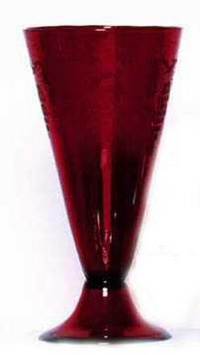 by Preston MacDougall December 12, 2005
Instead of hiding the truth, illusions can also be artfully employed to reveal it. Or at least one's take on it, as Tennessee Williams did in "The Glass Menagerie." Educators very often employ the same trick - such as when I project a computationally rendered image of a molecule during a chemistry class. In reality, molecules are much too small to see, and even the things that we can measure only seem "molecular" through the filter of our theoretical models.
Then there is the special case of the "The Glass Flowers" at Harvard. Conceived by a 19th century biology professor, George Goodale, so that botany students could study life-like tropical plants in Massachusetts, it was the father and son team of Leopold and Rudolph Blaschka who brought glass to life. With centuries of glass-working in their family tree, I am sure that every trick of the trade, and a few born of necessity, were employed in the five decades that it took to create the 3,000-plus models that make up the Ware Collection. The final addition was made in 1936, but just like its siblings, and as the good professor envisioned, it still appears freshly picked. When I visited the exhibit in 2003, the Venus' flytrap model looked just as menacing to Drosophila as it must have on the Blaschkas' workbench, back in Germany and almost a century ago. I imagine it being virtually indistinguishable from the once-living, but long-dead specimen that sat beside it. The formal name of the exhibit stems from the family name of the generous Harvard patrons who made Professor Goodale's dream come true. Mrs. Elizabeth Ware and her daughter, Mary Lee, commissioned the Blashka collection as a memorial to Dr. Charles Ware, class of 1834. "A rose by any other name would smell as sweet." Unless it was a sand rose, the informal name of the rosette-like forms of gypsum (which is twice-hydrated calcium sulfate) that have crystallized in sandy water - they don't smell at all. They're sharp too - the "petals" are called blades of gypsum for good reason. Since a sand rose isn't really a flower, you won't find one in the Ware Collection. You don't have to go far, however, since the entrance to the Mineralogical Museum at Harvard, also spectacular, is not even a stone's throw away. Most kinds of glass, such as those used by the Blaschkas, are made from the mineral quartz (which also has the chemical name of silica), after it is melted, or fused, with other minerals or chemical additives. These are added in order to give it color, sparkling brilliance, or desired mechanical properties. For instance, soda-lime-glass
is a blend of oxides of sodium (soda), calcium (lime) and silicon.
It will shatter if heated or cooled too rapidly. Adding boron
to the mix solves this problem. The problems associated with
marketing casserole dishes made of soda-lime-borosilicate were
solved by whoever came up with the name of Pyrex. Instead of burning sulfur, if you heat it gently, it will sublime. Then, on a nearby cool surface, there will form beautifully bright, yellow "flowers of sulfur." One row down from sulfur on the periodic table, is the element selenium. Its gaseous compounds also have interesting odors, but instead of clearing your sinuses, even at really low levels they will clear a large room. Flowers of selenium are also formed sublimely, but they are dark red. Selenium was once thought to be toxic at any level, but research has shown that male sterility and higher incidence of cancers result without it. As is the case for sulfur, flowers of selenium will not be found among the Glass Flowers at Harvard. But, if you look across the Charles River, the sky-scraping colored glass towers of Boston get some of their sun-screening properties from the selenium blended in the window glass. So, what is reality? Werner Heisenberg, a German theorist, famous for his uncertain principles, had the following take: What we observe is not nature itself, but nature exposed to our method of questioning.
Publish A Letter on SitNews Read Letters/Opinions Submit A Letter to the Editor
|
||
